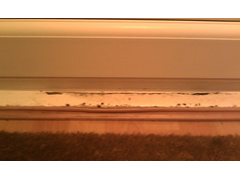gingerprince
|
| posted on 16/11/10 at 06:53 PM |

|
|
Door Sill Condensation
Wondering if anyone can help, what with all the varied knowledge on here.
We've recently had our old wooden front door replaced with PVCu. The old door was drafty as hell. The new one is obviously very well sealed.
The problem is, there's a bit of concrete under the door, which is the back of the concrete door sill that obviously goes from the outside. This
gets covered in condensation, and in just a couple of weeks it's already started to ruin the laminate floor trim, and will likely soon do the
same to the floor: -
 
Description
Obviously the old drafty door was doing a job in ventilating this area and reducing condensation, whereas now the humid in-house air is condensing on
the cold stone.
What's the best way to sort this, short of running a dehumidifier 24x7?
Ta.
|
|
|
|
|
JoelP
|
| posted on 16/11/10 at 07:02 PM |

|
|
do you notice condensation elsewhere in the house? My house is quite bad for it as there is no ventilation, so we have to open a window most days.
Cant think of a good solution, but you either need to make the step warmer, or reduce the moist air passing over it.
|
|
|
mistergrumpy
|
| posted on 16/11/10 at 07:04 PM |

|
|
I'm in a similar boat too. Forever having to redecorate.
|
|
|
PSpirine
|
| posted on 16/11/10 at 07:19 PM |

|
|
On the subject.. what is an accepted humidity level for a house?
I've got single-glazing in mine, and in winter some windows (understandably) get condensation on them, but I wouldn't say the house is in
any way damp etc.
As for the sill, my door apertures are drafty enough that it's effectively blowdrying any condensation that could form, which in itself
isn't ideal.
Pavs
|
|
|
nick205
|
| posted on 16/11/10 at 07:26 PM |

|
|
Similar issues here after replacing knackered wooden windows with PVCu items. Fitting trickle vents to the window frames has helped a little, but
it's still a problem in the bedrooms.
Can't think of a quick and easy solution for your step - I guess the proper solution would be to dig out the concrete and rebuild with some form
of insulated cavity - hassle you don't want I'm sure!
|
|
|
macc man
|
| posted on 16/11/10 at 07:55 PM |

|
|
I know you have already laid the floor but have you considered underfloor heating? Works well in most situations and does not cost much to run.
|
|
|
LBMEFM
|
| posted on 16/11/10 at 08:07 PM |

|
|
Anywhere were warm air touches cold gloss surfaces consensation will form. Dry the area fully, use "gripfill" or simular to fit a thin
strip of timber to the area then decorate to choice, Problem should go away. But as said ventilation is key, I see it all the time where clients seal
up their homes and immediately condensation/dampness is an issue.
|
|
|
norfolkluego
|
| posted on 16/11/10 at 09:40 PM |

|
|
Same problems here, we've got warm air central heating (for those who don't know it, the heating doesn't have radiators it blows
warm air through floor level vents into each room), works well enough but the boiler is in a moisture laden kitchen (great place to put it!). Last
summer I replaced an airbrick with a man sized extractor fan, bye bye condensation problems.
Think about it moist moisture will be generated in the kitchen (cooking/boiling kettles) and the bathroom (showers/baths) make sure those are both
properly ventilated (at this time of year that probably means extraction of moist air with fans).
[Edited on 16/11/10 by norfolkluego]
|
|
|
adam1985
|
| posted on 16/11/10 at 09:51 PM |

|
|
quote:
Originally posted by norfolkluego
Same problems here, we've got warm air central heating (for those who don't know it, the heating doesn't have radiators it blows
warm air through floor level vents into each room), works well enough but the boiler is in a moisture laden kitchen (great place to put it!). Last
summer I replaced an airbrick with a man sized extractor fan, bye bye condensation problems.
Think about it moist moisture will be generated in the kitchen (cooking/boiling kettles) and the bathroom (showers/baths) make sure those are both
properly ventilated (at this time of year that probably means extraction of moist air with fans).
[Edited on 16/11/10 by norfolkluego]
Be careful that the air brick wasnt there for the air heater and make sure the new fan doesnt effect the air heater
|
|
|
norfolkluego
|
| posted on 16/11/10 at 11:46 PM |

|
|
Good point but we had the original boiler (1960s vintage) replaced a couple of years ago, airbrick was no longer needed
|
|
|













